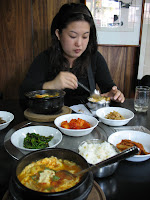barrio coreano
 Eunhye, my friend from la UBA Spanish classes when I first arrived, is back in Buenos Aires for six months and to celebrate we went for lunch in Barrio Coreano. I discovered the Korean area of the city is a mere ten blocks from my house, so I'll be able to pop back easily when I need more supplys of noodles, chocolate covered sunflower seeds, and garlic chives.
Eunhye, my friend from la UBA Spanish classes when I first arrived, is back in Buenos Aires for six months and to celebrate we went for lunch in Barrio Coreano. I discovered the Korean area of the city is a mere ten blocks from my house, so I'll be able to pop back easily when I need more supplys of noodles, chocolate covered sunflower seeds, and garlic chives. Korean Argentines call the neighbourhood, Baek–Ku from the Korean for 109. Koreans arriving in Buenos Aires in the 1960s, without any Spanish, would be told to take the number 109 bus to the area. Ironically, today the 109 doesn't go through the barrio!
Korean Argentines call the neighbourhood, Baek–Ku from the Korean for 109. Koreans arriving in Buenos Aires in the 1960s, without any Spanish, would be told to take the number 109 bus to the area. Ironically, today the 109 doesn't go through the barrio!In comparison to Barrio Chino, the area is quiet and it's only the Korean language signs that suggest a Korean presence. But on ringing a few bells we found traditional restaurants, and hidden stores secured behind gates and doors. And there we feasted on rice, kimchi and tofu vegetable soup.
Comments
Too bad the 109 don' run no mo'.
Wonderful post. Thank you!
Mike